About
Special News
Logan's Page
Jacoby's Page
Our Travel Index
Tracks Ahead Related Trips
Contact
Italy Trip - October 26 - November 9, 2015
Italy & The Dalmatian Coast
 |
We finally visit Italy, and cruise to several countries along the Adriatic Sea.
|
Introduction
Many people, when they start to travel to Europe, always seem to pick Italy. The history, the food, the scenery, and ancestral roots are often a big allure. In all our years of world traveling, somehow, we have always managed to skip Italy. This trip, booked spur of the moment, was our attempt to rectify this situation.
Sunday/Monday, October 25/26
Late today, we left home for Sky Harbor, and stayed at an airport
hotel. They had a "stay and store" program.
So we decided to drive down and leave car this time rather than
have friends pick us up. It was a
short night, as we had to catch the 4 AM shuttle to the airport.
After a four and a half hour flight to Newark, we then had a 3 hour layover and an eight and a half hour ride to Rome, arriving
7:15 AM on Tuesday. It was the
standard airplane flight. All I can say is that the movies
were good, the food adequate, and the legroom to small (even in economy
plus.) Eventhough the flight was not full, it was still tough to
get any sleep.
Tuesday, October 27
Arrived at the hotel around 9 AM. Rome is large, and traffic is miserable. We cleaned up a bit, and - probably unwisely - took a nap. Once we came back down to the lobby, we were greeted by Max, the concierge. This gentleman would prove invaluable during our short stay. He asked to see our itinerary, and immediately started changing things to work around the weather forecast. He said that the outdoor things which were scheduled for Wednesday, would be better today, as rain was expected. He contacted the tour company, and was apprently quite a handful, but managed to get things rearranged. And he was spot on, as today was just overcast. But Wednesday? It rained. We were just not in the mood to walk
the streets, so we headed for the hotel's rooftop restaurant. The
view was great. We had a VERY expensive ham and cheese
sandwich, and then killed some time waiting for our tour guide. Of
course, later we found that we could
have done much better on the street.
walk
the streets, so we headed for the hotel's rooftop restaurant. The
view was great. We had a VERY expensive ham and cheese
sandwich, and then killed some time waiting for our tour guide. Of
course, later we found that we could
have done much better on the street.
 Our driver picked us up at 2 and off we went to meet our guide at the
Coliseum. We came around a corner,
and there it was. We've all seen images of the place before, but
it was rather cool to be driving past it. As we had advance
tickets, we got right into the place, and climbed up to the level where
you could see the whole building. Some of it is original,
and some has been restored
Our driver picked us up at 2 and off we went to meet our guide at the
Coliseum. We came around a corner,
and there it was. We've all seen images of the place before, but
it was rather cool to be driving past it. As we had advance
tickets, we got right into the place, and climbed up to the level where
you could see the whole building. Some of it is original,
and some has been restored 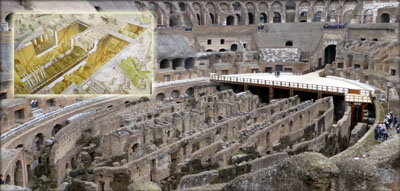 Part of the floor has been replaced, as
the Passion Play is performed here, as well as a few other events.
Of great interest to us was the center pit, which is where all the backstage work
and action took place. The animals, workers, slaves, whomever,
woulkd be lifted to appear through traps in the wooden floor of the
building. So it was just like a modern stage, but done with ropes,
pulley, wooden lifts and the technology of the time. Much of it
has been excavated, so you could get a grasp of what things must have
been like back in the day.
Part of the floor has been replaced, as
the Passion Play is performed here, as well as a few other events.
Of great interest to us was the center pit, which is where all the backstage work
and action took place. The animals, workers, slaves, whomever,
woulkd be lifted to appear through traps in the wooden floor of the
building. So it was just like a modern stage, but done with ropes,
pulley, wooden lifts and the technology of the time. Much of it
has been excavated, so you could get a grasp of what things must have
been like back in the day.  The carved wall reliefs were pretty
spectacular, and when you think about the fact that they were done about
2,000 years ago, it is amazing that they have held up so well.
Eventhough this was the end of the season, there were still loads of
people. And all with the damn selfie sticks. I think I am
going to hate those things. I’d hate to be here in high tourist season.
The carved wall reliefs were pretty
spectacular, and when you think about the fact that they were done about
2,000 years ago, it is amazing that they have held up so well.
Eventhough this was the end of the season, there were still loads of
people. And all with the damn selfie sticks. I think I am
going to hate those things. I’d hate to be here in high tourist season.
 We then moved on
to Circus Maximus, which was a big open field at this
point. This was the ventue for
chariot races and the like.
We then moved on
to Circus Maximus, which was a big open field at this
point. This was the ventue for
chariot races and the like.  Next up were the ruins of the Parthenon
and what remains of the Roman Forum. While it is a ruin, you can
still get a grasp of what things were like over 2,000 years ago. We stopped in a small
park, which had an adjoining school, and a compound that was for the
Malta Knights. If you looked
through the keyhole, you saw a image of the dome of St. Paul.
While many tried to take a picture, none succeeded.
So you’ll just have to take my word for the fact that it was
pretty cool.
Next up were the ruins of the Parthenon
and what remains of the Roman Forum. While it is a ruin, you can
still get a grasp of what things were like over 2,000 years ago. We stopped in a small
park, which had an adjoining school, and a compound that was for the
Malta Knights. If you looked
through the keyhole, you saw a image of the dome of St. Paul.
While many tried to take a picture, none succeeded.
So you’ll just have to take my word for the fact that it was
pretty cool.  Note
that we actually were here!
Note
that we actually were here! The tour continued
with a stop at Capitoline Hill. Everywhere you turned there were
statues. Here we find Castor and Pollux, as well as Marcus
Aurelius, and the ever presernt "SPQR" which is the Latin abbreviation
of the "The Senate and People of Rome."
The tour continued
with a stop at Capitoline Hill. Everywhere you turned there were
statues. Here we find Castor and Pollux, as well as Marcus
Aurelius, and the ever presernt "SPQR" which is the Latin abbreviation
of the "The Senate and People of Rome."  Our final stop was the
Pantheon. It was dark, so you could only really see the interior.
Note the inset of the "Roman Legionares" with whom you have your photo
taken. For a price.
Our final stop was the
Pantheon. It was dark, so you could only really see the interior.
Note the inset of the "Roman Legionares" with whom you have your photo
taken. For a price. We are tired, although are starting to feel better. We have early dinner scheduled (7:30 is the earliest that places open) and then we plan to be off to bed. Our new best bud Max was correct. It is supposed to rain tomorrow. The restaurant was Tullio, which is now on it’s third generation owner. Wow. Oh my. Yum, yum. Everything was delicious. This may become a regular stop.
Today dawned grey and as promised, with rain;
which was actually rather nice.
The grey skies and rain washed streets gave a really soft look to
Rome. Traffic here is pretty
bad. While not as chaotic as
India or Egypt, it is still pretty much, go fast, stop, and edge in
whenever you can. They do
stop for pedestrians, but like China, as a person afoot, you just have
to keep your head down and have faith that the drivers will think you
don’t see them and stop. I
would not want to drive here.
OK, that said, we have been many places all over the world.
I do not
 remember ever – EVER – seeing as many tourists as there
seem to be here. And this is
the end of the season. You
know how you always see St. Peter’s Square filled with people?
That’s because it is ALWAYS FILLED WITH PEOPLE.
Yikes. It just gets
to be a bit much. And those
stupid, stupid selfie sticks.
What a bunch of narcissists we have become.
All right, then.
Because we feared the rain, I mentioned that Max had taken it upon
himself to change the schedule
for today to be pretty much All Vatican, All the Time.
remember ever – EVER – seeing as many tourists as there
seem to be here. And this is
the end of the season. You
know how you always see St. Peter’s Square filled with people?
That’s because it is ALWAYS FILLED WITH PEOPLE.
Yikes. It just gets
to be a bit much. And those
stupid, stupid selfie sticks.
What a bunch of narcissists we have become.
All right, then.
Because we feared the rain, I mentioned that Max had taken it upon
himself to change the schedule
for today to be pretty much All Vatican, All the Time.

We started with the Vatican Museum, and saw a lot of statues, tapestries, and artifacts.

The ceilings were amazing in themselves, all painted, or carved, and very colorful and detailed.

The tapestries were actually drawn here, and then woven in Belgium, as they had the best weaving technology of the time.
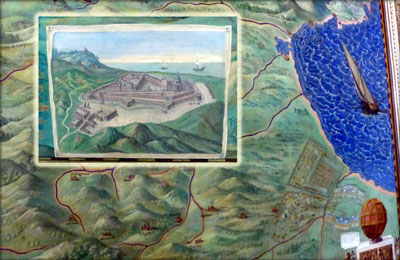 There were also painted maps of Italy, which we all found quite
interesting. We did the
museum shuffle for a couple of hours, before hitting the Sistine Chapel.
Smaller than we had thought, the place of course has the ceiling
by Michelangelo, and the side frescos by notables such as Bottecelli,
Donato, and others of the time.
The ceiling depicts the Book of Genesis, and is quite something.
It was cleaned back in the 2000 (I think) and really sparkles.
There were no photos allowed, so you will have to look in books
or get internet material to show.
We did not get to see the pope, as we were inside, warm (emphasis
on warm) and dry while the rest of the folks stayed outside in the rain
for a glimpse.
There were also painted maps of Italy, which we all found quite
interesting. We did the
museum shuffle for a couple of hours, before hitting the Sistine Chapel.
Smaller than we had thought, the place of course has the ceiling
by Michelangelo, and the side frescos by notables such as Bottecelli,
Donato, and others of the time.
The ceiling depicts the Book of Genesis, and is quite something.
It was cleaned back in the 2000 (I think) and really sparkles.
There were no photos allowed, so you will have to look in books
or get internet material to show.
We did not get to see the pope, as we were inside, warm (emphasis
on warm) and dry while the rest of the folks stayed outside in the rain
for a glimpse.
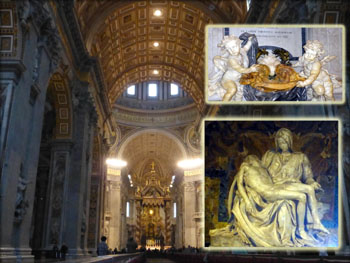 The final
tour was St. Paul’s Cathedral, which is – well, large.
The frontal lighting makes for tough shooting, which encourages
you to purchase the books.
But there are plenty of statues and reliefs on which to gaze.
The Pieta statue, done by Michelangelo is a highlight of the
place. Our guide, Maria
Teresa, left us at this point, and we wandered just a bit in the rain to
find a pizza restaurant, which was marginal.
On the other hand, it was dry, comfortable, and had good coffee.
Did I mention that it was dry?
That killed enough time so that by mid afternoon, we headed back
to the Vatican for the Scavi Tour.
The word simply means “excavation.”
The final
tour was St. Paul’s Cathedral, which is – well, large.
The frontal lighting makes for tough shooting, which encourages
you to purchase the books.
But there are plenty of statues and reliefs on which to gaze.
The Pieta statue, done by Michelangelo is a highlight of the
place. Our guide, Maria
Teresa, left us at this point, and we wandered just a bit in the rain to
find a pizza restaurant, which was marginal.
On the other hand, it was dry, comfortable, and had good coffee.
Did I mention that it was dry?
That killed enough time so that by mid afternoon, we headed back
to the Vatican for the Scavi Tour.
The word simply means “excavation.”
 As a side note, the Vatican has it’s own large scale remote van
complete with pushouts and all in 1080p.
Nice. Another side
note. The Vatican State is a
separate entity. So it has
its own pharmacy, rules, etc.
In fact, some medicines are put on the market much faster here,
as there is less paperwork.
When you think about it, they have to have their own food standards,
etc. Do I know how much they
have adopted from the Italians?
No, but they can pretty much do what they want.
I wonder if they can generate their own nuclear power?
As a side note, the Vatican has it’s own large scale remote van
complete with pushouts and all in 1080p.
Nice. Another side
note. The Vatican State is a
separate entity. So it has
its own pharmacy, rules, etc.
In fact, some medicines are put on the market much faster here,
as there is less paperwork.
When you think about it, they have to have their own food standards,
etc. Do I know how much they
have adopted from the Italians?
No, but they can pretty much do what they want.
I wonder if they can generate their own nuclear power?
 And of course, they have their own ceremonial police force, the
Swiss Guards. Why Swiss
Guards. Because when the
popes started to hire protection forces, all the militaries in Europe
were mercenaries. And the
Swiss were the cheapest. I
seem to have read that while they are “ceremonial,” they are actually
highly trained with good combat skills.
Of course, those are the guys you don’t see.
Anyway, on to the Scavi Tour.
Excavations under St. Peter’s Cathedral have revealed vast
necropolises. In addition to
St. Peter’s Tomb, rich Roman families buried their dead in [essentially]
mausoleums to be close to Peter.
Peter's tomb has 18 human bones (the 19th is in the Pope's private
chapel) that are visible behind glass protection.
The tour was rather interesting, and about right at 90 minutes.
We were held up a bit by, what else, a French group, about whom
our guide has less than kind words.
As did we. No photos were
allowed, so again, you'll have to take my word for what it looked like. Back to
the hotel, home, home, home, and then off to
Rinaldies, a fish restaurant.
Dinner was as good as last night.
Oh yeah.
If you ever come to Rome, try the Rinaldi restaurant.
Oh boy. Great fish,
excellent risotto, generally another great experience.
And a weird thing called seaside mushrooms. They were strange, but
good. And we lived to tell of them.
I think if we lived here, we would weigh a lot more than we do
now. And so the evening
comes to an end. We are
walked out, satiated with good food,wine and limoncello.
Off to bed.
And of course, they have their own ceremonial police force, the
Swiss Guards. Why Swiss
Guards. Because when the
popes started to hire protection forces, all the militaries in Europe
were mercenaries. And the
Swiss were the cheapest. I
seem to have read that while they are “ceremonial,” they are actually
highly trained with good combat skills.
Of course, those are the guys you don’t see.
Anyway, on to the Scavi Tour.
Excavations under St. Peter’s Cathedral have revealed vast
necropolises. In addition to
St. Peter’s Tomb, rich Roman families buried their dead in [essentially]
mausoleums to be close to Peter.
Peter's tomb has 18 human bones (the 19th is in the Pope's private
chapel) that are visible behind glass protection.
The tour was rather interesting, and about right at 90 minutes.
We were held up a bit by, what else, a French group, about whom
our guide has less than kind words.
As did we. No photos were
allowed, so again, you'll have to take my word for what it looked like. Back to
the hotel, home, home, home, and then off to
Rinaldies, a fish restaurant.
Dinner was as good as last night.
Oh yeah.
If you ever come to Rome, try the Rinaldi restaurant.
Oh boy. Great fish,
excellent risotto, generally another great experience.
And a weird thing called seaside mushrooms. They were strange, but
good. And we lived to tell of them.
I think if we lived here, we would weigh a lot more than we do
now. And so the evening
comes to an end. We are
walked out, satiated with good food,wine and limoncello.
Off to bed.
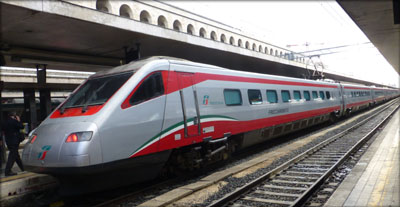 We took off early this morning, only to find
that our driver had forgotten us.
So we took a cab to the train station.
Yes, that’s right.
Today, we rode The TRAIN. It
was an interregional which went up to Milan, stopping at Florence on the
way. Our traveling companion was a
crab fisherman from Canada, who regaled us with tales of his 28 years on
the sea.
We took off early this morning, only to find
that our driver had forgotten us.
So we took a cab to the train station.
Yes, that’s right.
Today, we rode The TRAIN. It
was an interregional which went up to Milan, stopping at Florence on the
way. Our traveling companion was a
crab fisherman from Canada, who regaled us with tales of his 28 years on
the sea.

So after about 90 minutes of a super smooth ride, through mostly tunnels, we arrived to meet our day guide, Alexandra.
 Florence was one of the power houses of the Italian peninsula,
and this is where the Medici family was located.
Starting as wool merchants, they eventually parlayed their wealth
into banking and were one of the most powerful families in Italy.
While we did not take the tour, we were able to glimpse the inner
courtyard. Further evidence of the family's power is to be found
all over the city in the form orm art and statuary.
Florence was one of the power houses of the Italian peninsula,
and this is where the Medici family was located.
Starting as wool merchants, they eventually parlayed their wealth
into banking and were one of the most powerful families in Italy.
While we did not take the tour, we were able to glimpse the inner
courtyard. Further evidence of the family's power is to be found
all over the city in the form orm art and statuary.

The town itself is quite charming, with narrow winding streets.
 The narrow,
winding streets make for some interesting vehicles.
Note the Renault Twizy, an all electric NEV about the size of our
golf cart.
The narrow,
winding streets make for some interesting vehicles.
Note the Renault Twizy, an all electric NEV about the size of our
golf cart.
 The rich families
of Florence decided to build a church, and they wanted something that
represented their power and status. The result is the Church of Santa Maria de Fiora (St. Mary
of the Lily) and the whole thing is fronted in marble.
The dome took 14 years to build and was constructed after the rest
of the church was complete because the technology for building such a
large dome was not quite there.
The problem was eventually solved with a double dome, with the
smaller inner one supporting the larger, lighter outer dome.
The rich families
of Florence decided to build a church, and they wanted something that
represented their power and status. The result is the Church of Santa Maria de Fiora (St. Mary
of the Lily) and the whole thing is fronted in marble.
The dome took 14 years to build and was constructed after the rest
of the church was complete because the technology for building such a
large dome was not quite there.
The problem was eventually solved with a double dome, with the
smaller inner one supporting the larger, lighter outer dome.
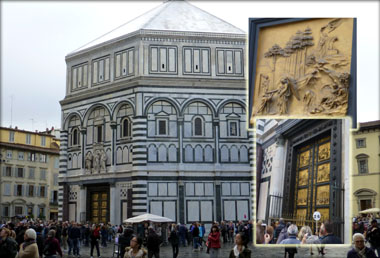 A
separate structure, the Bapistry was pretty remarkable with its three dimensional
bronze door. The casting of
the three dimensional bronze panels took years to perfect.
There was a huge flood here in 1966, and a lot of stuff has been cleaned and
refurbished. The current
pope is visiting in the spring, so things are even more spruced up.
A
separate structure, the Bapistry was pretty remarkable with its three dimensional
bronze door. The casting of
the three dimensional bronze panels took years to perfect.
There was a huge flood here in 1966, and a lot of stuff has been cleaned and
refurbished. The current
pope is visiting in the spring, so things are even more spruced up.
 Next on the list was the Academy which housed the Michelangelo
statue of David. Of course, the
photo is one picture that everyone who comes here has in their
collection. And we are no exception. A part of the statude
was destroyed some years back, by a wacko weilding a hammer. He
managed to damage a toe, but that's about it.
Next on the list was the Academy which housed the Michelangelo
statue of David. Of course, the
photo is one picture that everyone who comes here has in their
collection. And we are no exception. A part of the statude
was destroyed some years back, by a wacko weilding a hammer. He
managed to damage a toe, but that's about it.
 Michelangelo was one of those artists that could see the figure in the
stone. So rather than make a
plaster model, and then take exact measurements in carving the marble,
he just picked a block, and cut away anything that didn’t look like his
subject. There were some
unfinished blocks that really demonstrated how the figure seemed to leap
out of the stone.
Michelangelo was one of those artists that could see the figure in the
stone. So rather than make a
plaster model, and then take exact measurements in carving the marble,
he just picked a block, and cut away anything that didn’t look like his
subject. There were some
unfinished blocks that really demonstrated how the figure seemed to leap
out of the stone.

On to the Pont de Vecchio Bridge. The structures built out from the sides all all shops.
 Close
by, is the U shaped Uffizi art gallery, home to works by Da Vinci, Bottacelli, Caravaggio,
and other notables of the time.
The subject was mostly the Madonna and child, which was the
religious theme du jour. I must
say, no matter where you turned, it was art work - statudes, painting,
ceilings. It is too much to take in.
Close
by, is the U shaped Uffizi art gallery, home to works by Da Vinci, Bottacelli, Caravaggio,
and other notables of the time.
The subject was mostly the Madonna and child, which was the
religious theme du jour. I must
say, no matter where you turned, it was art work - statudes, painting,
ceilings. It is too much to take in.
 After a while, I did sort of glaze over.
There was some remarkable material, though, and one painting
featured just a single figure painted by Da Vinci.
The original artist threw down his brushes and never painted
again, becoming famous in sculpture.
After a while, I did sort of glaze over.
There was some remarkable material, though, and one painting
featured just a single figure painted by Da Vinci.
The original artist threw down his brushes and never painted
again, becoming famous in sculpture.
 Off to the main square, with another marble fronted church.
We stopped at a
leather store, and then had a coffee in a café.
We are both dead tired.
We took an expensive cab ride back to the train station, and
caught the 1519 back to Rome.
Off to the main square, with another marble fronted church.
We stopped at a
leather store, and then had a coffee in a café.
We are both dead tired.
We took an expensive cab ride back to the train station, and
caught the 1519 back to Rome.

Our driver Marco was there to meet us, and we were off for dinner
to a very crowded, but very good Tullio again.
A short walk after dinner and a photo op in front of the fountain in the
square. What a great way to spend our last night in Rome.
We slept in this morning, and had a leisurely
breakfast. After that it was a
matter of pulling all our stuff together, going down the street to buy a
bottle of Jameson’s, and waiting for Marco, our driver.
Tips for Max and staff were left.
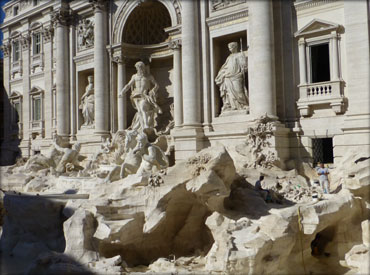 Again,
without the assistance and "take charge" attitude of Max, the concierge,
things would have been much less pleasent during our whirlwind tour of
Rome.
Marco showed up right on time and detoured so that we could see
the Trevi Fountain. This has
been made famous in countless films, such as Fellini’s “La Dolce Vita”
but more so by “Roman Holiday.”
Unfortunately, like the Spanish Steps, the fountain is closed and
being cleaned. Just our
luck. So we were not able to
throw a coin in it. So we
don’t know if we will return to Rome.
Again,
without the assistance and "take charge" attitude of Max, the concierge,
things would have been much less pleasent during our whirlwind tour of
Rome.
Marco showed up right on time and detoured so that we could see
the Trevi Fountain. This has
been made famous in countless films, such as Fellini’s “La Dolce Vita”
but more so by “Roman Holiday.”
Unfortunately, like the Spanish Steps, the fountain is closed and
being cleaned. Just our
luck. So we were not able to
throw a coin in it. So we
don’t know if we will return to Rome.
 The closure, though, did not seem to lessen the number of
tourists. Off we went to
Civitavecchia and the MS Riviera, our Oceana cruise ship, and home for
the next 8 nights. And so
the eating contest has started.
We are on the concierge level, and have our own lounge, which I
have yet to try. I did start
a load of laundry, figuring that no one else would be dumb enough to
wash at the beginning of a cruise.
Au contrare. There
was a other couple doing the same thing.
Dave and Sandy are a really nice couple from San Diego, and
we chatted for a bit.
The closure, though, did not seem to lessen the number of
tourists. Off we went to
Civitavecchia and the MS Riviera, our Oceana cruise ship, and home for
the next 8 nights. And so
the eating contest has started.
We are on the concierge level, and have our own lounge, which I
have yet to try. I did start
a load of laundry, figuring that no one else would be dumb enough to
wash at the beginning of a cruise.
Au contrare. There
was a other couple doing the same thing.
Dave and Sandy are a really nice couple from San Diego, and
we chatted for a bit.
 We
watched the sun slip slowly into the Mediterranean and cracked opn our
smuggled in bottle of booze. We
had the obligatory lifeboat drill, and there is the late show for
entertainment. At dinner we had a
shared table, with a couple from London (Andrew and Marge).
We was a retired British surveyor, which in his case was a
combination of home appraiser and building inspector.
He specialized in older homes, say 100-300 years old, so knew all
about older construction methods.
The other couple (Linda/Linni & Jim?) were retired primary school
teachers from California.
The dinner was lovely, and a Temperanillo wine was good.
The late show, was a string quartet. Really? I was out like a light.
We
watched the sun slip slowly into the Mediterranean and cracked opn our
smuggled in bottle of booze. We
had the obligatory lifeboat drill, and there is the late show for
entertainment. At dinner we had a
shared table, with a couple from London (Andrew and Marge).
We was a retired British surveyor, which in his case was a
combination of home appraiser and building inspector.
He specialized in older homes, say 100-300 years old, so knew all
about older construction methods.
The other couple (Linda/Linni & Jim?) were retired primary school
teachers from California.
The dinner was lovely, and a Temperanillo wine was good.
The late show, was a string quartet. Really? I was out like a light.
It was smooth sailing last night, but rather windy. We could hear the wind whistling around the balcony door. So it was rather nice to be bundled under the comforter, snug and warm.
 The wind did not
abate, so we were forced to bypass our intended destination, which was
Sorrento, the jewel of the Amalfi Coast/Peninsula.
The wind was too strong (30 knots) and the seas to rough for us
to safely tender in to the shore.
So this is about as much of Sorrento we will see.
Just up the coast, and better protected, though, lies Naples.
The wind did not
abate, so we were forced to bypass our intended destination, which was
Sorrento, the jewel of the Amalfi Coast/Peninsula.
The wind was too strong (30 knots) and the seas to rough for us
to safely tender in to the shore.
So this is about as much of Sorrento we will see.
Just up the coast, and better protected, though, lies Naples.
 There is a harbor and piers there, so off we went.
The tours that were supposed to go from Sorrento, instead were
quickly repositioned in Naples.
Things started about an hour later, after a tug helped us turn
around and shoved us up against the pier for mooring.
There is a harbor and piers there, so off we went.
The tours that were supposed to go from Sorrento, instead were
quickly repositioned in Naples.
Things started about an hour later, after a tug helped us turn
around and shoved us up against the pier for mooring.
 Our tour today was to Pompeii.
This was a Roman city and port of around 15,000 people, until
79AD. On that day, Mt.
Vesuvius erupted. Drawings
depict lava inundating the town, but if that had been the case, all
would have been melted.
Instead, a rolling cloud of sulfur dioxide rolled down the mountainside
and suffocated the inhabitants.
It happened pretty quickly, so life was pretty much stopped at
that instant. The following
ash cloud buried the city in up to 30 meters of ash, which hardened over
time. The city was completely
buried, and the result was an archeological treasure and UNESCO World
Heritage site. The whole
thing was discovered in the early 1700s by peasants who were digging a
well. Scavengers and looters
followed, but eventually the government stepped in and contained the
place. Digging has been
going on ever since. What
has been exposed is an amazing ruin of streets, houses, shops, baths, the
other elements of Roman life in 79AD.
Our tour today was to Pompeii.
This was a Roman city and port of around 15,000 people, until
79AD. On that day, Mt.
Vesuvius erupted. Drawings
depict lava inundating the town, but if that had been the case, all
would have been melted.
Instead, a rolling cloud of sulfur dioxide rolled down the mountainside
and suffocated the inhabitants.
It happened pretty quickly, so life was pretty much stopped at
that instant. The following
ash cloud buried the city in up to 30 meters of ash, which hardened over
time. The city was completely
buried, and the result was an archeological treasure and UNESCO World
Heritage site. The whole
thing was discovered in the early 1700s by peasants who were digging a
well. Scavengers and looters
followed, but eventually the government stepped in and contained the
place. Digging has been
going on ever since. What
has been exposed is an amazing ruin of streets, houses, shops, baths, the
other elements of Roman life in 79AD.
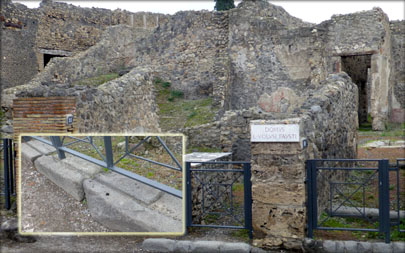 Shops are easy to spot, as there was always a groove in the stone
in front of the shop. This
was for a sliding wooden door to close the place.
We were told that stores sold primarily grains and oils, although
I would guess that other things such as leather goods and textiles were
available. And of course,
someone had to sell chariot repair material.
Shops are easy to spot, as there was always a groove in the stone
in front of the shop. This
was for a sliding wooden door to close the place.
We were told that stores sold primarily grains and oils, although
I would guess that other things such as leather goods and textiles were
available. And of course,
someone had to sell chariot repair material.
 The houses had beautiful frescos, wall paintings, interior baths
and gardens. The whole thing
is really something to see.
It is remarkable to see the figures of people and animals which were
painted around 2,000 years ago.
The color is still vibrant and detailed.
There were flowers, and hunting scenes;.
This place must have been remarkable when it was new.
There were two theaters, one holding around 2,000 people, the
other a smaller one.
The houses had beautiful frescos, wall paintings, interior baths
and gardens. The whole thing
is really something to see.
It is remarkable to see the figures of people and animals which were
painted around 2,000 years ago.
The color is still vibrant and detailed.
There were flowers, and hunting scenes;.
This place must have been remarkable when it was new.
There were two theaters, one holding around 2,000 people, the
other a smaller one.
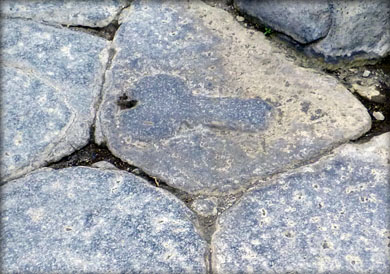 Prostitution was legal at the time, and a brothel survived, complete
with a street marker providing direction.
However, while legal, the owners of such establishments were not
held in particularly high regard.
Apparently this shop owner got tired of being asked for sirections, and
chiseled mthis marker in front of his shop.
Prostitution was legal at the time, and a brothel survived, complete
with a street marker providing direction.
However, while legal, the owners of such establishments were not
held in particularly high regard.
Apparently this shop owner got tired of being asked for sirections, and
chiseled mthis marker in front of his shop.
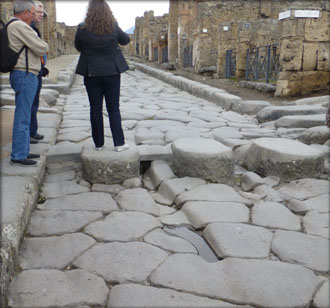 The stone streets had worn grooves made by the wagons, and every
so often, you would find a set of stepping stones for pedestrians, so
that they did not have to walk in the street.
The baths were elaborate, and some featured steam heating.
The ritual was a hot bath, followed by a cold plunge.
The stone streets had worn grooves made by the wagons, and every
so often, you would find a set of stepping stones for pedestrians, so
that they did not have to walk in the street.
The baths were elaborate, and some featured steam heating.
The ritual was a hot bath, followed by a cold plunge.

Water was brought in by aqueduct, although lead pipes were used. No wonder people had visions, after the exposure to lead. Some of the pipes are still visible.
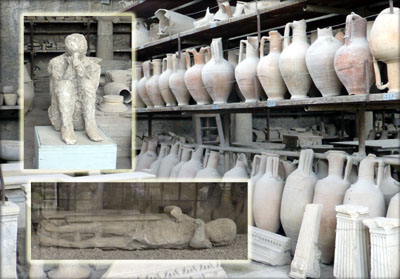 There were preserved bodies, but the only thing on display were
the figures of a man, a small child and a dog.
There were stores of bowls and amphora to been seen, all removed
from the site. We had the
obligatory visit to a local endeavor, this time a cameo shop, and of
course, there were the usual shops of trinkets and the like.
There were preserved bodies, but the only thing on display were
the figures of a man, a small child and a dog.
There were stores of bowls and amphora to been seen, all removed
from the site. We had the
obligatory visit to a local endeavor, this time a cameo shop, and of
course, there were the usual shops of trinkets and the like.
Around 50% of Italy’s economy depends on tourism.
There were plenty of people here, but nowhere near as many as
in Rome. By mid afternoon we
were back on the ship. Did I
mention that our AC did not work yesterday?
The maintenance guy came and got it working, and today, it is
freezing in here. We have
reservations at one of the special dining rooms tonight – French.
I hope it isn’t bad meat disguised with sauce.
The dinner at Jacques was quite good.
Our dinner companions were a couple from Belgium & Denmark (Luk &
Anne) and a couple from Spokane (Bill & Joan).
Bill was an electrical engineer, and did some computer
programming on the side.
Sound familiar? Luk & Anne
had an interesting story.
Married for 55 years, they first met when she was but 13 ½ when both
were on holiday in Italy. He
was a little older, and said to his brother, “That’s the girl I’m going
to marry.” They corresponded
for several years, and eventually married.
Pretty cool, hum? And if you
look up the phrase "classy couple" in the dictionary, their photo will
be there. We
had a nice dinner discussion, and then it was off to bed for what some
though a rough passage to Sicily.
Barb and I just found it to be a rather nice rocking motion.
So here we are in Messina, Sicily.
Carmelo? Messina?
Sicily is a volcanic area, quite prone to earthquakes, and
produces the majority of the citrus for Italy.
The tourist trade, and resort areas are also wonderful, with
great beaches, and sunny weather.
However, that was NOT the case today, as it rained.
All day it rained.
 Messina itself was just a drive through, with a nice church and great
bell towner. The figures move with
the bell strikes. The city itself
has about a quarter of a million people.
As previously mentioned, it is earthquake prone, and a big one in 1908 killed 60,000 of
the towns then 120,000 inhabitants.
Being Sunday, things were a little slow, with closed shops, and
no traffic.
Messina itself was just a drive through, with a nice church and great
bell towner. The figures move with
the bell strikes. The city itself
has about a quarter of a million people.
As previously mentioned, it is earthquake prone, and a big one in 1908 killed 60,000 of
the towns then 120,000 inhabitants.
Being Sunday, things were a little slow, with closed shops, and
no traffic.
We hopped on the autostrada and headed to Taormina. The road was quite an engineering feat. The terrain is volcanic basalt, with steep valleys and cliffs. There were a lot of cantilevered road and approach sections, and a multitude of tunnels. This was not an inexpensive engineering project.
 It really stated to rain once we reached Taormina.
There was an open Roman theater that is still in use, as well as
a nice little church that was built on Roman ruins.
The town was charming, with narrow winding streets.
But it really was not a lot of fun in the rain.
Plus we were encouraged to shop (Free Time!) and that was not so
much fun in the rain either.
Barb was the smartest of all.
After the bus dropped us off, and it really started to rain, she
bolted for a coffee shop, and had a cappuccino and a wonderful pistachio
filled croissant. It looked
gross, but it was delicious.
I joined her after the theater visit, and we were joined by a fellow
passenger, Bill, whose wife wisely stayed aboard ship.
There was a band contest of some sort, and a group played
It really stated to rain once we reached Taormina.
There was an open Roman theater that is still in use, as well as
a nice little church that was built on Roman ruins.
The town was charming, with narrow winding streets.
But it really was not a lot of fun in the rain.
Plus we were encouraged to shop (Free Time!) and that was not so
much fun in the rain either.
Barb was the smartest of all.
After the bus dropped us off, and it really started to rain, she
bolted for a coffee shop, and had a cappuccino and a wonderful pistachio
filled croissant. It looked
gross, but it was delicious.
I joined her after the theater visit, and we were joined by a fellow
passenger, Bill, whose wife wisely stayed aboard ship.
There was a band contest of some sort, and a group played
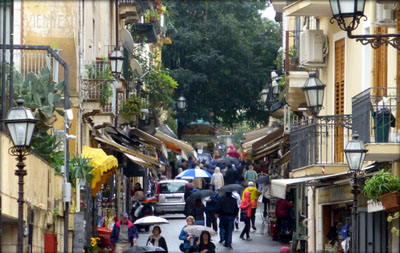 right
in the town square. That did
sort of liven things up for the end of our visit.
To see an impression of this lovely little town, please
click on the photo.
right
in the town square. That did
sort of liven things up for the end of our visit.
To see an impression of this lovely little town, please
click on the photo.
We dutifully filed back on the bus, on our way up to Mt. Etna and
the crater. The volcano is
still active, but is closely monitored.
But is is raining (did I mention that?) and foggy, and we have
yet to see the mountain. We
had lunch in the little town of Cavatina?, where we discovered that the
road to the mountain had been blocked with a landslide due to the rain.
So that was off the agenda.
Instead we had an opportunity to go to a tasting of olive oil and
local produce. Can you say,
“More shopping?” We did
succumb to some olive oil for kid’s gifts.
The town itself was dead.
D E A D. It is
Sunday, and raining. So
there was no one about.
Places were locked up tight.
Even the petrol stations were closed.
Back on the bus and a snoozy ride back to Messina.
Dinner tonight is at the Polo Grill.
Sounds like meat.
Actually, no. The grill
turned out to have swordfish, oysters Rockefeller, and other yummy
delictebles. The ride was a
big rough, as we were crossing the bottom of the Aegean Sea, and it was
a dark and stormy night – complete with lots of lightening.
The restaurant was on deck 14, so the motion was exacerbated by
the height. Which made for
some interesting wine pouring by the staff.
We dined alone, and had a lovely time.
The show was a high performance song and dance revue by the
staff. I love those things,
so was quite entertained. We
staggered to bed, after setting the clocks ahead an hour because of a
new time zone. We rocked ad
rolled all night long, and it was quite comforting.
 The didn’t dock this morning until 11 AM, and it
was bright and sunny, unlike the last two days.
So the blue sky offset the green shores of the island. What a
change.
We are on the largest of the Ionian Islands, Cephalonia.
It apparently has a lot of wildlife, and great beaches.
Argostoli is the largest city on the island, which has a current
population of around 55,000. We have a Noon tour of the town and some
caves. Ok, this was a much
better day than yesterday.
After a hearty breakfast, we traipsed off the boat, onto buses, which
took us on a very winding switchback road to our first destination.
The island has the third largest mountain in Greece, and is very
steep, with deep ravines, and shear cliffs.
It is a great tourist spot for beaches, diving, and just
relaxing. It is quite
beautiful, but as our guide said, quite hot.
Last year it was 42 degrees for several days, and humid.
She said it was miserable.
Apparently the islanders are known as the “Crazy Cephadonians.” as
they have their own unique style. The guide told us of the
reason, but I missed it, and no amount of internet searching can find
anything definitive.
The
The didn’t dock this morning until 11 AM, and it
was bright and sunny, unlike the last two days.
So the blue sky offset the green shores of the island. What a
change.
We are on the largest of the Ionian Islands, Cephalonia.
It apparently has a lot of wildlife, and great beaches.
Argostoli is the largest city on the island, which has a current
population of around 55,000. We have a Noon tour of the town and some
caves. Ok, this was a much
better day than yesterday.
After a hearty breakfast, we traipsed off the boat, onto buses, which
took us on a very winding switchback road to our first destination.
The island has the third largest mountain in Greece, and is very
steep, with deep ravines, and shear cliffs.
It is a great tourist spot for beaches, diving, and just
relaxing. It is quite
beautiful, but as our guide said, quite hot.
Last year it was 42 degrees for several days, and humid.
She said it was miserable.
Apparently the islanders are known as the “Crazy Cephadonians.” as
they have their own unique style. The guide told us of the
reason, but I missed it, and no amount of internet searching can find
anything definitive.
The
 first stop was the Drogarati Cave, which required many steps to go
into. The cave itself wasn’t
too bad, but it was a cave in the limestone rock with run of the mill
stalagtites and stalagmites.
And those steps that it took to descend into the cave?
They required climbing to get out of the cave.
But still, it was an entertaining stop.
first stop was the Drogarati Cave, which required many steps to go
into. The cave itself wasn’t
too bad, but it was a cave in the limestone rock with run of the mill
stalagtites and stalagmites.
And those steps that it took to descend into the cave?
They required climbing to get out of the cave.
But still, it was an entertaining stop.
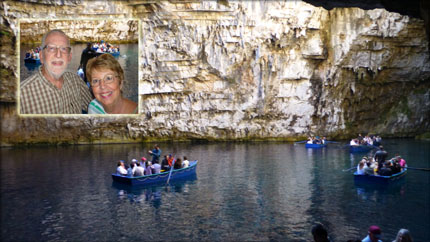 The next cave was better.
This was the subterranean Melissani Lake.
This is technically a cave, with an open top, as the roof caved
in about 300 years ago due to an earthquake.
The acoustics in the place are so good that opera singer Maria
Callas once wanted to sing in the place.
The water is a mixture of salt water and fresh water from the
island and is crystal clear. Explorers
found several pagan idols inside, so the place was known to ancient
people as a temple.
The next cave was better.
This was the subterranean Melissani Lake.
This is technically a cave, with an open top, as the roof caved
in about 300 years ago due to an earthquake.
The acoustics in the place are so good that opera singer Maria
Callas once wanted to sing in the place.
The water is a mixture of salt water and fresh water from the
island and is crystal clear. Explorers
found several pagan idols inside, so the place was known to ancient
people as a temple.

Note the olives. But they have no pimento stuffing? How can this be? And they look better in a martini.
 We
returned via a different road, that allowed us additional looks at the
island and the rugged landscape.
The island is quite earthquake prone, but fortunately, we did not
experience one.
We
returned via a different road, that allowed us additional looks at the
island and the rugged landscape.
The island is quite earthquake prone, but fortunately, we did not
experience one.

The trip back also allowed us a look at the causeway which was built across the lagoon. Originally built as a wooden structure, storms kept washing it away. In 1823 the British Protectorate built a stone bridge and causeway that linked Argostoli to the mainland. Now it is just a scenic walkway.
 The
return also allowed a good look at the MS Riviera. At 1200
passengers, it is a largest ship in the Oceana fleet.
We had a brief lunch and a drink with Sandy and Dave Cox, new
acquaintenances from San Diego.
The
return also allowed a good look at the MS Riviera. At 1200
passengers, it is a largest ship in the Oceana fleet.
We had a brief lunch and a drink with Sandy and Dave Cox, new
acquaintenances from San Diego.
And then it was time for a late dinner at the Italian specialty
restaurant, which turned out to be just so so.
On the upside of the day, the island of
Cephadonia was really beautiful.
 This morning we sailed up the Bay of Kotor, into
Montenegro. The Bay is
considered to be one of the most beautiful fjords in the world.
Technically, it isn’t a fjord, but a submerged river canyon.
No matter what it is called, it is a beautiful way to get into a
protected area, which has the town of Kotor at the end.
This morning we sailed up the Bay of Kotor, into
Montenegro. The Bay is
considered to be one of the most beautiful fjords in the world.
Technically, it isn’t a fjord, but a submerged river canyon.
No matter what it is called, it is a beautiful way to get into a
protected area, which has the town of Kotor at the end.
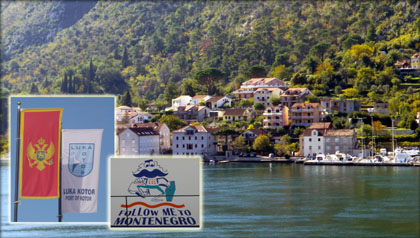 The country of Montenegro only has a population of around
650,000, and Kotor has around 13,500+ of that.
The city has a distinctive Venetian feel to it, as there was a
great deal of influence from that area. The Venetian Republic did build
the city wall. All along the
passage are clustered little towns, all with a resort feel.
The country is also about 70% mountain, so there is not a great
deal of agriculture. Rather
than just hang around the town, we opted for the Scenic Montenegro
drive.
The country of Montenegro only has a population of around
650,000, and Kotor has around 13,500+ of that.
The city has a distinctive Venetian feel to it, as there was a
great deal of influence from that area. The Venetian Republic did build
the city wall. All along the
passage are clustered little towns, all with a resort feel.
The country is also about 70% mountain, so there is not a great
deal of agriculture. Rather
than just hang around the town, we opted for the Scenic Montenegro
drive.
 Our bus driver took
us up a VERY steep series of switchbacks (29 in all) that offered amazing views of
the Kotor Bay, the mountains, and the vegetation.
The sights were spectacular.
The road was a strictly a one lane affair, and the locals must
avoid it during the tourist time.
We did meet a few cars, but this was strictly a one way, scenic
drive.
Our bus driver took
us up a VERY steep series of switchbacks (29 in all) that offered amazing views of
the Kotor Bay, the mountains, and the vegetation.
The sights were spectacular.
The road was a strictly a one lane affair, and the locals must
avoid it during the tourist time.
We did meet a few cars, but this was strictly a one way, scenic
drive.

We had a tourist stop, and a short (questionable) lunch at a tourist restaurant. Proscuito is a featured item, and we were told that the people here make it in a slightly different manner than in other places.
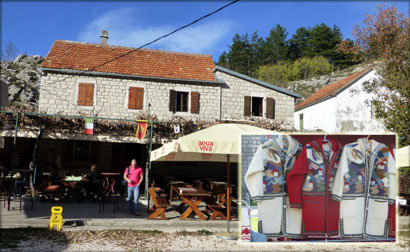 Of
course, there were plenty of opportunities to purchase things.
I confess to a short nap.
Hey. I had a beer
with lunch. Some local
swill, which was ctually pretty good.
Of
course, there were plenty of opportunities to purchase things.
I confess to a short nap.
Hey. I had a beer
with lunch. Some local
swill, which was ctually pretty good.
 I
don't know what it is about local beers. They are pretty much all
good. Well, except for that nasty stuff in the Falklands. Our bus went as far
as Cetinje, which was once the government center of the country.
I
don't know what it is about local beers. They are pretty much all
good. Well, except for that nasty stuff in the Falklands. Our bus went as far
as Cetinje, which was once the government center of the country.
 We toured the Museum of Nicholas the First, though no photos were
allowed. This is a chapel on the
grounds, and not the museum itself.
We toured the Museum of Nicholas the First, though no photos were
allowed. This is a chapel on the
grounds, and not the museum itself.
We were then back on the bus, headed down the mountains to Kotor, past the Budva Riviera and some great beaches.
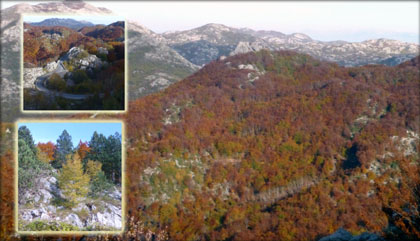 Of
course, everything is pretty much closed, as this is the end of the
season. It definitely is a
resort area, with prices commensurate with such.
It was dark by the time we returned to Kotor, and we just headed
back to the ship rather than walk about the town.
If you want beautiful scenery with a mountain flair, then this is
the place. Grey, craggy
mountains and autumn colors made for a very beautiful impression.
Dinner was with two couples we have met, in the general dining
room.
Of
course, everything is pretty much closed, as this is the end of the
season. It definitely is a
resort area, with prices commensurate with such.
It was dark by the time we returned to Kotor, and we just headed
back to the ship rather than walk about the town.
If you want beautiful scenery with a mountain flair, then this is
the place. Grey, craggy
mountains and autumn colors made for a very beautiful impression.
Dinner was with two couples we have met, in the general dining
room.
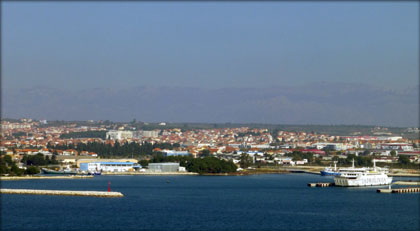 We slept late again today, as the ship sailed
into the waters off Croatia.
We docked around 11 AM, at the port of Zadar, the fifth largest city
(75,000) in
the country. The economy
of Croatia is driven primarily by tourism, but around 8% is agriculture
(wine, olives), and about 23 % industrial (salt, fish farms, and boat
building). About 80% of the
population are Croates, and mostly Catholic.
Zadar was heavily damaged in the war between rebel Serbs in
1991-1995, but after twenty years, it has mostly been rebuilt.
There was little evidence of war, other than pretty much all new
buildings.
We slept late again today, as the ship sailed
into the waters off Croatia.
We docked around 11 AM, at the port of Zadar, the fifth largest city
(75,000) in
the country. The economy
of Croatia is driven primarily by tourism, but around 8% is agriculture
(wine, olives), and about 23 % industrial (salt, fish farms, and boat
building). About 80% of the
population are Croates, and mostly Catholic.
Zadar was heavily damaged in the war between rebel Serbs in
1991-1995, but after twenty years, it has mostly been rebuilt.
There was little evidence of war, other than pretty much all new
buildings.

We drove to the small town of Nin and were greeted with the oldest preserved monument depicting a Croatian medieval ruler. Duke Branimir ruled Croatia from 879-892 and this statue was originaly part of a church he built.
 The
old town itself is on an island, and contained a church
and foundations dating back to the Roman era.
There was a nice little archeological museum.
Many of the relics dated back to Roman times, as would be expected.
The
old town itself is on an island, and contained a church
and foundations dating back to the Roman era.
There was a nice little archeological museum.
Many of the relics dated back to Roman times, as would be expected.

On the way out, I found a universal sign.
 One of the main industries here is salt.
So naturally we visited the salt museum.
They use evaporation, after the seawater is filtered through 18
meters of mineral laden mud.
The plant is seasonal, running primarily in the summer months.
So all we really saw were ponds and bags being filled.
Still, we learned about regular table salt and salt flowers,
which is the skim off the top and quite different.
And of course, there was a train so I just had to include a photo.
One of the main industries here is salt.
So naturally we visited the salt museum.
They use evaporation, after the seawater is filtered through 18
meters of mineral laden mud.
The plant is seasonal, running primarily in the summer months.
So all we really saw were ponds and bags being filled.
Still, we learned about regular table salt and salt flowers,
which is the skim off the top and quite different.
And of course, there was a train so I just had to include a photo.
 Then it was back on the bus and into Zadar.
The first stop was an art project called the Greeting of the Sun,
at the harbor point. Next to
it was the Sea Organ, which was another art project, featuring 35 pipes
that are driven by the sea.
The sound is then generated by the air pressure differential.
Someone actually asked if it could be turned off. Initially, that
sounded like a bogus question, but upon reflection, it is actually sa
sensible query. Because after about 2 minutes of this, it gets
pretty annoying. Click on the picture above to see what I mean.
Then it was back on the bus and into Zadar.
The first stop was an art project called the Greeting of the Sun,
at the harbor point. Next to
it was the Sea Organ, which was another art project, featuring 35 pipes
that are driven by the sea.
The sound is then generated by the air pressure differential.
Someone actually asked if it could be turned off. Initially, that
sounded like a bogus question, but upon reflection, it is actually sa
sensible query. Because after about 2 minutes of this, it gets
pretty annoying. Click on the picture above to see what I mean.
 We walked down the promenade, through the old 16th
century city walls, and into the old town.
There were more churches, but were left to free time for a bit to
explore the narrow streets which were laid out by the Romans.
This was again a very pretty city.
Then back to the ship.
Dinner tonight was in the main dining room with new friends.
The evenings entertainment was the cruise director
who did a one man show, which was a great deal of fun.
We walked down the promenade, through the old 16th
century city walls, and into the old town.
There were more churches, but were left to free time for a bit to
explore the narrow streets which were laid out by the Romans.
This was again a very pretty city.
Then back to the ship.
Dinner tonight was in the main dining room with new friends.
The evenings entertainment was the cruise director
who did a one man show, which was a great deal of fun.
 Our ship docked in Slovania this
slightly foggy morning.
It’s about half the size of Switzerland, and has a population of
around 2 million people. It
is small enough, that at the most, it will take you about three hours to
drive across. The economy
hinges on tourism, and aluminum smelting.
In fact, we saw lots of aluminum roll, billet and ingot on the
dock. And there is a big
container shipping port here as well.
We are right on the Italian and Austrian borders, so you can get
by with a mix of German, Slovakian, and Italian.
The Bosnian War bypassed this place, and as of 2007, the country
has been a full-fledged member of the EU.
You could tell, as things were looking pretty prosperous.
Our ship docked in Slovania this
slightly foggy morning.
It’s about half the size of Switzerland, and has a population of
around 2 million people. It
is small enough, that at the most, it will take you about three hours to
drive across. The economy
hinges on tourism, and aluminum smelting.
In fact, we saw lots of aluminum roll, billet and ingot on the
dock. And there is a big
container shipping port here as well.
We are right on the Italian and Austrian borders, so you can get
by with a mix of German, Slovakian, and Italian.
The Bosnian War bypassed this place, and as of 2007, the country
has been a full-fledged member of the EU.
You could tell, as things were looking pretty prosperous.
 We were up early for our hop on, hop off bus tour.
Ah, but not so fast.
The tour was not the traditional hop on hop off, but rather a hop on,
taste, and get back on.
There were four little cities involved here:
Koer, Izola, Portoros, and Piran.
We took the bus to Piran, which was a charming, picturesque town.
Obviously, sailing is a major activity here.
We were up early for our hop on, hop off bus tour.
Ah, but not so fast.
The tour was not the traditional hop on hop off, but rather a hop on,
taste, and get back on.
There were four little cities involved here:
Koer, Izola, Portoros, and Piran.
We took the bus to Piran, which was a charming, picturesque town.
Obviously, sailing is a major activity here.
 The door indicates that Napoleon slept here, or so they think.
And the lion with his paw on an open book indicates that peace
was attained here through treaties and other peaceful means.
A closed book would indicate fighting.
The door indicates that Napoleon slept here, or so they think.
And the lion with his paw on an open book indicates that peace
was attained here through treaties and other peaceful means.
A closed book would indicate fighting.

The main square at Piran was picturesque, and we actually saw some school children. I think that is a first on this trip. The mermain sculpture at the end of the town offered a lovely view into the sea.
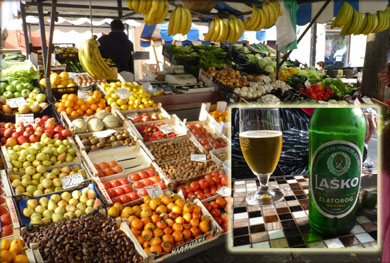 We wandered for a bit, had a cup of coffee, and departed for
Portoros. We did not stop
there, as it looked to be pretty much a resort area.
So we moved on to Izola.
We had a yummy piece of chocolate cake (the tasting, remember?)
and wandered a bit. The colorful market was not as much of a draw.
Better to sit in a local bar and have a Lazko, one of the local beers.
Again, there weren’t any shops open, other than the standard
small department stores. So
on we went to Koper. Again,
there was nothing other than some scenery.
Everything appears to be well maintained, and everything looked
fairly prosperous. The cars
were all fairly new. We
skipped the church. After
walking through town, it was back to the ship.
Dinner is at Polo again this evening.
That is one of four specialty restaurants on board.
The French one is good, Polo is excellent, the Thai infusion
place is being skipped, and the Italian one was not to our liking.
It’s a shared table tonight.
We have been lucky twice, so let’s see what this event brings.
Later. We were lucky again, having dinner with two other couples.
One was retired from ConEd in NewYork, living in Florida.
His wife was a perky, bouncy Sicilian woman (Shirley & Rich) who
reminded me of Barb C. She
was quite the chatterbox.
The other couple (Bruce & Mary Jo) had both worked for AmEx, and he was
fluent in Chinese. He had
helped out with the Chinese table tennis thing back in the 70’s and had
met Nixon. He had lived
quite an interesting life.
His wife was from San Francisco on the 60’s/70’s and was equally as
interesting. A good time was
had by all. Or, at least we
would like to think so.
We wandered for a bit, had a cup of coffee, and departed for
Portoros. We did not stop
there, as it looked to be pretty much a resort area.
So we moved on to Izola.
We had a yummy piece of chocolate cake (the tasting, remember?)
and wandered a bit. The colorful market was not as much of a draw.
Better to sit in a local bar and have a Lazko, one of the local beers.
Again, there weren’t any shops open, other than the standard
small department stores. So
on we went to Koper. Again,
there was nothing other than some scenery.
Everything appears to be well maintained, and everything looked
fairly prosperous. The cars
were all fairly new. We
skipped the church. After
walking through town, it was back to the ship.
Dinner is at Polo again this evening.
That is one of four specialty restaurants on board.
The French one is good, Polo is excellent, the Thai infusion
place is being skipped, and the Italian one was not to our liking.
It’s a shared table tonight.
We have been lucky twice, so let’s see what this event brings.
Later. We were lucky again, having dinner with two other couples.
One was retired from ConEd in NewYork, living in Florida.
His wife was a perky, bouncy Sicilian woman (Shirley & Rich) who
reminded me of Barb C. She
was quite the chatterbox.
The other couple (Bruce & Mary Jo) had both worked for AmEx, and he was
fluent in Chinese. He had
helped out with the Chinese table tennis thing back in the 70’s and had
met Nixon. He had lived
quite an interesting life.
His wife was from San Francisco on the 60’s/70’s and was equally as
interesting. A good time was
had by all. Or, at least we
would like to think so.
 We sailed ino a very hazy Venice this morning.
We were up and about and ready for our 10 AM tour.
This was of course, by boat.
An aside here. Who in
their right mind decides to build a major city on a bunch of islands and
a swamp, and then doesn’t fill it in?
We sailed ino a very hazy Venice this morning.
We were up and about and ready for our 10 AM tour.
This was of course, by boat.
An aside here. Who in
their right mind decides to build a major city on a bunch of islands and
a swamp, and then doesn’t fill it in?

Be that as it may, Venice is quite something. The canels and the buildings seemingly immersed in water are a sight to behold. In fact, I'd recommend seeing it before rising sea levels inundate the place.
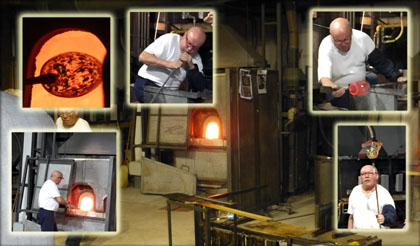 We first headed to Murano Glass works.
We had the usual glassmaking demo wherein a master craftsman
started with a bunch of silica, rolled it in colored sand and elements,
and then proceeded to blow a vase. I guess you just have to
remember never to inhale!
We first headed to Murano Glass works.
We had the usual glassmaking demo wherein a master craftsman
started with a bunch of silica, rolled it in colored sand and elements,
and then proceeded to blow a vase. I guess you just have to
remember never to inhale!
Then we had – shopping time. There were some absolutely beautiful pieces the purchase. And the prices were commensurate with one of a kind items. One of the chandeliers came in at 100,100 Euros. We did find much less expensive items in the bargain basement, and again helped the Italian economy.
 We
were then off for a brief stop at San Giorgio Maggiore Island, and yet
another church.The church was lovely, and
while some merely turned their backs on the place for a scenic view of
St. Marks and the belltower, one other individual just seemed to take it
all in. The bell tower is a copy, as the original collapsed in
1902.
We
were then off for a brief stop at San Giorgio Maggiore Island, and yet
another church.The church was lovely, and
while some merely turned their backs on the place for a scenic view of
St. Marks and the belltower, one other individual just seemed to take it
all in. The bell tower is a copy, as the original collapsed in
1902.
 We returned
via St. Marks Square. I
guess I was expecting something more, but we will return again tomorrow,
so perhaps I will be more impressed.
The square was relatively empty, but the walkway along the Grand Canal
was loaded with vendors and tourists. Again, we are amazed at the
crowds.
We returned
via St. Marks Square. I
guess I was expecting something more, but we will return again tomorrow,
so perhaps I will be more impressed.
The square was relatively empty, but the walkway along the Grand Canal
was loaded with vendors and tourists. Again, we are amazed at the
crowds.
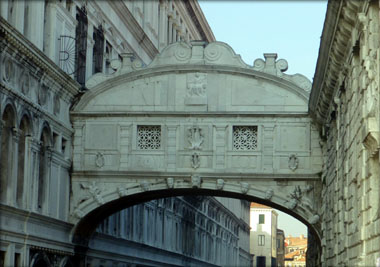
We did see a lot of bridges over the small canals that thread the city. The Bridge of Sighs is right there, a block off the waterfront.
 We had a gondola ride and did the usual tourist thing there.
The gondoliers were a bit less than enthusiastic about all this, as it
was a frequent sight to see them poling and texting at the same time.
They are primarily used in the small waterways between the islands,
although they do venture into the Grand Canal. Our friends took a
class in how to propel one of these things. Standing and poling.
They said it was tricky, but I guess if you do it enough times, it
becomse easy. Oh. Our gondelier did not sing. But he
did whistle a few bars of "Que Sera."
We had a gondola ride and did the usual tourist thing there.
The gondoliers were a bit less than enthusiastic about all this, as it
was a frequent sight to see them poling and texting at the same time.
They are primarily used in the small waterways between the islands,
although they do venture into the Grand Canal. Our friends took a
class in how to propel one of these things. Standing and poling.
They said it was tricky, but I guess if you do it enough times, it
becomse easy. Oh. Our gondelier did not sing. But he
did whistle a few bars of "Que Sera."
 You
are right up close to the buildings. On close inspection, they look to be in pretty poor
repair, at least in my opinion.
There are broken drain pipes, crumbling mortar and huge lag bolts
holding things together. I
would think of them as a maintenance nightmare.
I kept thinking of the Bond movie where the house has the airbags, and
then collapses.
And I would not have wanted to fall into the canal water, or to
even touch it. The gondolas
were ornate, and it really was a bit of a thrill to get a ride.
You could imagine a dark night, smoky torches, late evening assignations, etc.
You
are right up close to the buildings. On close inspection, they look to be in pretty poor
repair, at least in my opinion.
There are broken drain pipes, crumbling mortar and huge lag bolts
holding things together. I
would think of them as a maintenance nightmare.
I kept thinking of the Bond movie where the house has the airbags, and
then collapses.
And I would not have wanted to fall into the canal water, or to
even touch it. The gondolas
were ornate, and it really was a bit of a thrill to get a ride.
You could imagine a dark night, smoky torches, late evening assignations, etc.

The gondolas are all sleek and brightly painted, although black seems to be the standard hull color. We did pass a boatyard that repairs and builds these things. The yearly use does take an amount of wear and tear. And some of the fitting are polished and intricate.
We again had some free time for what else, shopping.
Then it was back to the boat to pack.
We leave tomorrow.
Our farewell dinner was with Dave & Sandy, and as we saw Doug & Julie
Moore, included them as well.
We again had way more food than we needed, and had a great time.
While we turned in right on time, I think the lack of boat motion
made us uneasy, as we awoke several times.
 Today we left to good ship MS Riviera, and met
our guide at the disembarkation point.
Our luggage was transferred to a water taxi, which took us to the
Hotel San Angelo, right on the Grand Canal.
Today we left to good ship MS Riviera, and met
our guide at the disembarkation point.
Our luggage was transferred to a water taxi, which took us to the
Hotel San Angelo, right on the Grand Canal.
 Venice was built on 118
small swampy islands. Each island was it’s own little
neighborhood. Each had its
own square, water supply (collected rainwater, until an aqueduct brought
in water) and a church. And all are
connected by some 400 bridges. When
Napoleon conquered the place, some of the churches were destroyed, but
most remain intact. As our
room was not yet ready, we wandered a bit, and stopped at a coffee shop
and sat. The map of this
place looks like one of those newspaper puzzle mazes.
There are tons of little alleys and walkways.
Everyone says that it is easy to get lost here, and I can see
how. You really do need a
map until you learn the city.
And I can't image how long that takes.
Venice was built on 118
small swampy islands. Each island was it’s own little
neighborhood. Each had its
own square, water supply (collected rainwater, until an aqueduct brought
in water) and a church. And all are
connected by some 400 bridges. When
Napoleon conquered the place, some of the churches were destroyed, but
most remain intact. As our
room was not yet ready, we wandered a bit, and stopped at a coffee shop
and sat. The map of this
place looks like one of those newspaper puzzle mazes.
There are tons of little alleys and walkways.
Everyone says that it is easy to get lost here, and I can see
how. You really do need a
map until you learn the city.
And I can't image how long that takes.

As you cross the bridges from one island to the next, you constantly see gondoliers in their striped shirts providing high priced boat rides on the inside canals.
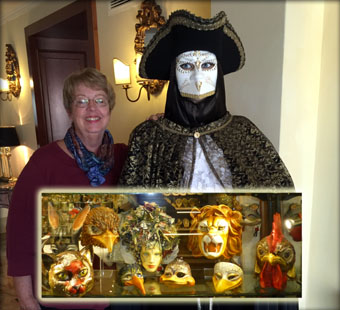 The shops sell many, many paper mache masks.
This is because Carnival (Mardi Gras) started here.
Originally the period was supposed to be 40 days of fun, prior to
the 40 days of Lent. So
there were parties, drinking, all sorts of riotous activities.
And because people didn’t want others to recognize who they were,
doing particular things, gowns and masks became a tradition.
So male or female, who knew who was who?
Eventually, the 40 days stretched into five months.
That’s a lot of partying!
We met our guide, Christine, at 2 PM.
The shops sell many, many paper mache masks.
This is because Carnival (Mardi Gras) started here.
Originally the period was supposed to be 40 days of fun, prior to
the 40 days of Lent. So
there were parties, drinking, all sorts of riotous activities.
And because people didn’t want others to recognize who they were,
doing particular things, gowns and masks became a tradition.
So male or female, who knew who was who?
Eventually, the 40 days stretched into five months.
That’s a lot of partying!
We met our guide, Christine, at 2 PM.

Along the walk to St. Mark's Square, we passed one of the restored homes. In this case the rear fencing had been removed, which exposed the inner courtyard. These places had their own cisterns for water, and had a wonderful rear staircase.

It was but a short continuing walk to St. Mark’s Square. The square is well known, and filled with both tourists and pigeons. I don’t know which are more annoying. The plan was to see St. Mark's Basilica and the Doge's Palace, both if which are pretty amazing. The basilica was first. The original building was all brick, but once the Venetians conquered Constantinople, they pirated tons of marble and artifacts from there, and brought it here to face out the brick of the church. Why St. Mark's? Because the city either bought or stole the body and tomb of St. Mark from Alexandria, Egypt. The tomb is in the sacristy of the church, as well as an amazing alter piece of gold and precious gems. The only reason that Napoleon didn’t steal the piece for the Louvre, is that the Venetians wisely covered it with a fax panel.

The ceiling is all gold and colored glass mosaic, and pretty spectacular. There were no photos allowed, so you will have to see for yourself.
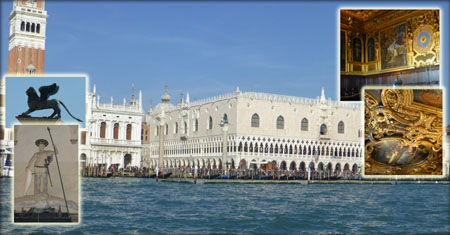 Next stop on the square was the Doge’s Palace.
Venice was a republic, and was administered by 2,000 senators,
who were elected every year.
They appointed a figurehead of the Republic: the Doge.
He had no power, and was often on committees, just to provide the
tie breaking vote. That did
not stop some of the Doge’s from trying to gain total power over the
republic. When caught, the
perpetrator
was beheaded on the palace steps.
We saw some of the meeting rooms, some decorated with gold leaf, and paintings by
masters such as Titian and Bellini.
The republic had it’s own secret police, the Council of Ten.
They looked after the security of the republic, and stemmed any
attempts by senators or the doge at insurrection.
We saw the prison, and crossed the Bridge of Sighs, so named
because that was the last glimpse of freedom that prisoners saw.
Or the first glimpse, if they were found innocent and released.
By the time we got to the golden Staircase, we were pretty
whipped.
Next stop on the square was the Doge’s Palace.
Venice was a republic, and was administered by 2,000 senators,
who were elected every year.
They appointed a figurehead of the Republic: the Doge.
He had no power, and was often on committees, just to provide the
tie breaking vote. That did
not stop some of the Doge’s from trying to gain total power over the
republic. When caught, the
perpetrator
was beheaded on the palace steps.
We saw some of the meeting rooms, some decorated with gold leaf, and paintings by
masters such as Titian and Bellini.
The republic had it’s own secret police, the Council of Ten.
They looked after the security of the republic, and stemmed any
attempts by senators or the doge at insurrection.
We saw the prison, and crossed the Bridge of Sighs, so named
because that was the last glimpse of freedom that prisoners saw.
Or the first glimpse, if they were found innocent and released.
By the time we got to the golden Staircase, we were pretty
whipped.

We wandered back to
Sant Angelo Square, had wine in the same coffee shop as this morning,
and a light dinner someplace along the way.
The pasta and wine here are really good.
I ordered a full liter of the house wine, and we just had to finish it.
We are in the hotel room, and will be here all night.
I don’t care if Italians don’t eat until 8.
We are done.
 This was our final day in Venice.
And that really is about as long as we wish to stay.
Truthfully, there really isn’t a great deal to do here except,
eat, shop, and wander about.
And of course you need to marvel that the place is still standing after
all these years. After all,
it’s a whole city, sitting on millions of wooden pilings, hand driven into the earth
three hundred years ago.
Things are uneven and tilting as a result.
In my opinion, like New Orleans, it is a city worth seeing once.
This was our final day in Venice.
And that really is about as long as we wish to stay.
Truthfully, there really isn’t a great deal to do here except,
eat, shop, and wander about.
And of course you need to marvel that the place is still standing after
all these years. After all,
it’s a whole city, sitting on millions of wooden pilings, hand driven into the earth
three hundred years ago.
Things are uneven and tilting as a result.
In my opinion, like New Orleans, it is a city worth seeing once.
 We started the day with a walk up to the Rialto Bridge.
As usual, every available space is filled with shops, be they
high end or souvenier, and tons of people.
We bought passes on the local water bus system, the vaporetto,
and rode all the way to the end of the line on in both directions.
We started the day with a walk up to the Rialto Bridge.
As usual, every available space is filled with shops, be they
high end or souvenier, and tons of people.
We bought passes on the local water bus system, the vaporetto,
and rode all the way to the end of the line on in both directions.
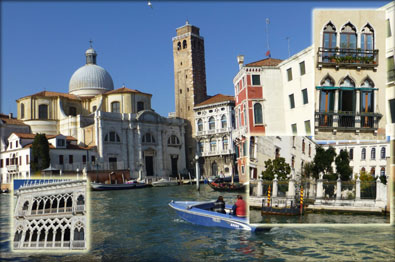
The far end is at the train station, the other at Lido Island. Along the way there were plenty of examples of gothic and Moorish influence in the buildings.
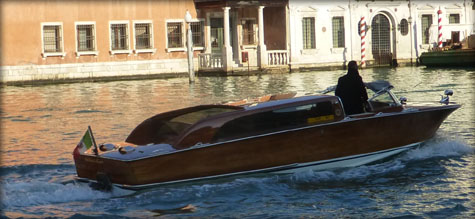
There were plenty of water taxi’s about, as well as the gondolas. The water taxis are sleek craft, that look like a reproduction of an old Garwood or somesuch. They are quite plush inside, and comfortable. Several we rode in featured LED lighting and ample speakers for that "serenade in Venice" feel.
It is amazing that there are not any collisions, as the watercraft pass very close to each other. It really was quite relaxing just sitting and watching the traffic pass us by.
 We will
get cleaned up, repacked and ready for the long flights home.
We have had a fun two weeks.
We are glad we have finally been able to check Italy off our list
of places. And we have
managed to add several other countries (Slovakia, Croatia, Montenegro)
to our roster –We have an early out tomorrow, so will leave here by
water taxi at a little past 4 AM.
I’ll feel better when our bags are checked in at the airport.
It’s been fun, but it’s now time to get back to reality.
We will
get cleaned up, repacked and ready for the long flights home.
We have had a fun two weeks.
We are glad we have finally been able to check Italy off our list
of places. And we have
managed to add several other countries (Slovakia, Croatia, Montenegro)
to our roster –We have an early out tomorrow, so will leave here by
water taxi at a little past 4 AM.
I’ll feel better when our bags are checked in at the airport.
It’s been fun, but it’s now time to get back to reality.
Of course, we both got little sleep last night.
So we were up at 3 AM, with the water taxi arriving at 4:15.
The night manager was really talkative, and fixed us up with a go
bag of snacks and coffee, after informing us that the taxi would not be
able to deliver us to the airport due to fog.
So he took us as far as a taxi stand, and we got a cab to rest of
the way. That necessitated a
final trip to an ATM to pay the guy, as I was out of Euros.
The fog really was thick.
Takeoff for Munich as slightly delayed because of it, and Barb
was amazed that we launched at all.
We got out and up into the sunlight, and then proceeded to chase
the sun west for the rest of the day.
We had three hours to kill in the Houston airport, which was made
painful by the fact that some woman had purchased a whistle for her
young daughter. She then
blew the damn thing for two hours. Memo to self – never buy Logan a
whistle. So we finally got
to Phoenix, arriving home about 10:30.
It was a great trip, but it certainly is nice to be back in our
own beds.